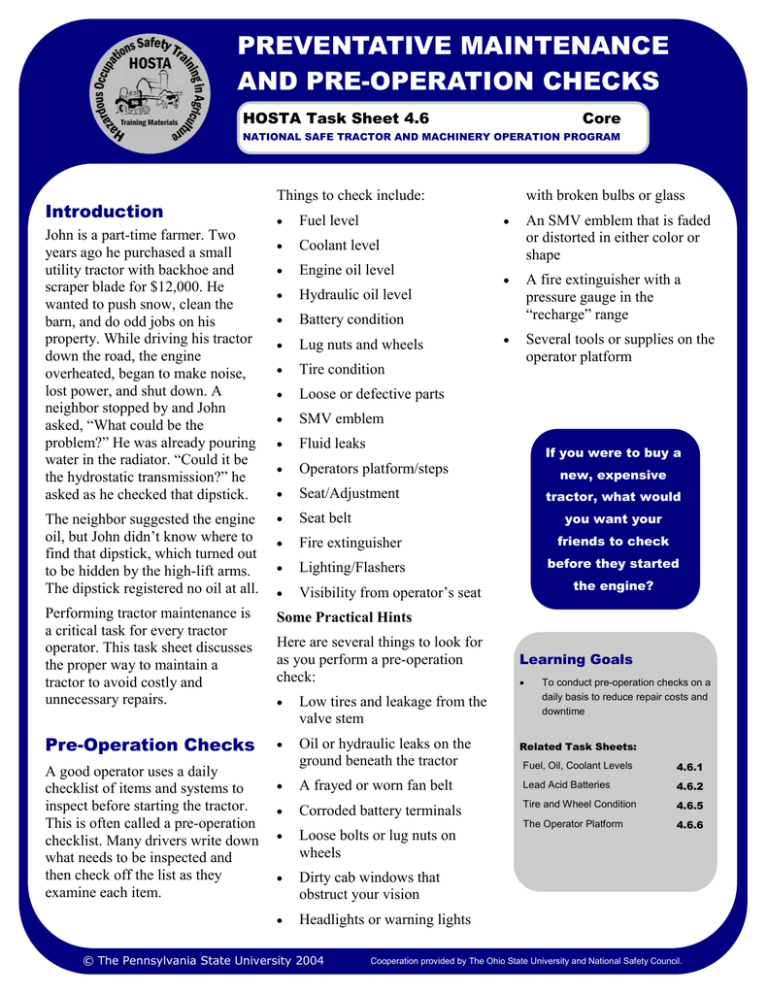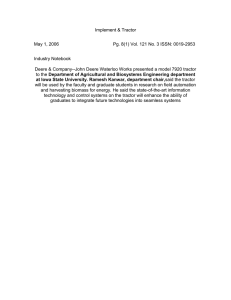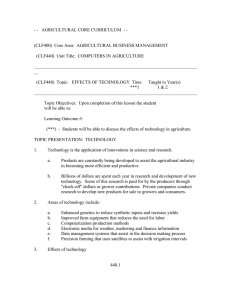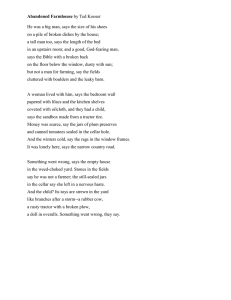
PREVENTATIVE MAINTENANCE
AND PRE-OPERATION CHECKS
HOSTA Task Sheet 4.6
Core
NATIONAL SAFE TRACTOR AND MACHINERY OPERATION PROGRAM
Introduction
Things to check include:
with broken bulbs or glass
•
Fuel level
•
Coolant level
•
Engine oil level
•
Hydraulic oil level
•
Battery condition
•
Lug nuts and wheels
•
Tire condition
•
Loose or defective parts
•
SMV emblem
•
Fluid leaks
•
Operators platform/steps
•
Seat/Adjustment
The neighbor suggested the engine
oil, but John didn’t know where to
find that dipstick, which turned out
to be hidden by the high-lift arms.
The dipstick registered no oil at all.
•
Seat belt
•
Fire extinguisher
friends to check
•
Lighting/Flashers
before they started
•
Visibility from operator’s seat
Performing tractor maintenance is
a critical task for every tractor
operator. This task sheet discusses
the proper way to maintain a
tractor to avoid costly and
unnecessary repairs.
Some Practical Hints
•
Low tires and leakage from the
valve stem
Pre-Operation Checks
•
Oil or hydraulic leaks on the
ground beneath the tractor
John is a part-time farmer. Two
years ago he purchased a small
utility tractor with backhoe and
scraper blade for $12,000. He
wanted to push snow, clean the
barn, and do odd jobs on his
property. While driving his tractor
down the road, the engine
overheated, began to make noise,
lost power, and shut down. A
neighbor stopped by and John
asked, “What could be the
problem?” He was already pouring
water in the radiator. “Could it be
the hydrostatic transmission?” he
asked as he checked that dipstick.
A good operator uses a daily
checklist of items and systems to
inspect before starting the tractor.
This is often called a pre-operation
checklist. Many drivers write down
what needs to be inspected and
then check off the list as they
examine each item.
•
An SMV emblem that is faded
or distorted in either color or
shape
•
A fire extinguisher with a
pressure gauge in the
“recharge” range
•
Several tools or supplies on the
operator platform
If you were to buy a
new, expensive
tractor, what would
you want your
Here are several things to look for
as you perform a pre-operation
check:
the engine?
Learning Goals
•
To conduct pre-operation checks on a
daily basis to reduce repair costs and
downtime
Related Task Sheets:
Fuel, Oil, Coolant Levels
4.6.1
•
A frayed or worn fan belt
Lead Acid Batteries
4.6.2
•
Corroded battery terminals
Tire and Wheel Condition
4.6.5
The Operator Platform
4.6.6
•
Loose bolts or lug nuts on
wheels
•
Dirty cab windows that
obstruct your vision
•
Headlights or warning lights
© The Pennsylvania State University 2004
Cooperation provided by The Ohio State University and National Safety Council.
Page 2
PREVENTATIVE MAINTENANCE AND PRE-OPERATION CHECKS
Don’t start the
engine until you
have completed the
“walk-around”
inspection and are
sure all systems are
ready to work for
you.
Safe Starts
Some newer utility or lawn tractors
may have safety start systems. If
so, the owner should also have in
good working order one or both of
the following items:
Seat Switch/Safety Interlock that
prevents starting the tractor if the
operator is not in the seat
A good operator
takes
responsibility for
the tractor he or
she operates.
Neutral-Start Safety Switch that
prevents the tractor from starting if
the tractor is in gear
Safety Activities
1. Make a chart of maintenance items to be done on your tractor. Use the following format, or develop your
own chart. If you have a computer, make a spreadsheet or database project to help with maintenance
records.
Tractor Maintenance Log
Date
Item Checked
Problem Found
Corrective Action
2. Help someone change the oil and oil filter on a tractor.
3. Help someone change an air filter on a tractor.
4. Call a tractor dealer/service center, and ask for any maintenance charts or record forms that they can send to
you.
5. Memorize the “pre-op” checklist, and recite this list as you conduct a pre-operation inspection for your class
or an interested adult.
6. Math Problem: You forgot to check the engine oil in the tractor before starting. When the oil light came on,
you continued working. Now the engine must be rebuilt to the amount of $5000. This is the only tractor that
can pull the forage harvester and chop 40 acres per day for the next 5 days. An estimated nutrient loss value
of $10 per acre will occur due to the delay in harvest. Calculate the dollar loss to the producer.
References
1. Farm and Ranch Safety Management, John
Deere Publishing, 1994.
2. Safe Operation of Agricultural Equipment,
Student Manual, 1988, Silletto and Hull, Hobart
Publications.
3. Owners’ Manuals for specific tractors.
Contact Information
National Safe Tractor and Machinery Operation Program
The Pennsylvania State University
Agricultural and Biological Engineering Department
246 Agricultural Engineering Building
University Park, PA 16802
Phone: 814-865-7685
Fax: 814-863-1031
Email: NSTMOP@psu.edu
Credits
Developed, written and edited by WC Harshman, AM Yoder, JW Hilton and D J Murphy,
The Pennsylvania State University. Reviewed by TL Bean and D Jepsen, The Ohio State
University and S Steel, National Safety Council.
Version 4/2004
This material is based upon work supported by the Cooperative State Research, Education, and Extension
Service, U.S. Department of Agriculture, under Agreement No. 2001-41521-01263. Any opinions, findings,
conclusions, or recommendations expressed in this publication are those of the author(s) and do not
necessarily reflect the view of the U.S. Department of Agriculture.
© The Pennsylvania State University 2004
Cooperation provided by The Ohio State University and National Safety Council.
FUEL, OIL, AND COOLANT LEVELS
HOSTA Task Sheet 4.6.1
NATIONAL SAFE TRACTOR AND MACHINERY OPERATION PROGRAM
Introduction
A tractor is a huge investment to
make farm work more efficient.
Even a mid-size tractor may cost
$40,000 or more.
The tractor must be kept in top
operating condition. Downtime for
engine and tractor repairs are
costly. An engine rebuild may cost
over $5000 in parts and labor. A
crop in the field may be lost
because of harvest delays. Crop
losses can lead to increased costs
to purchase replacement feeds or
protein supplements.
Figure 4.6.1.a. Before driving the tractor to the field, check for the possibility of an empty fuel tank.
If you run out of fuel during a workday, you are causing downtime losses.
What to Do
Therefore, tractor and equipment
pre-operation checks are an
economic necessity. A damaged
engine or an empty fuel tank at the
farthest field from the barn is no
excuse for the skilled operator.
This task sheet discusses the
importance of checking the fluid
levels of the
•
fuel
•
coolant, and
•
oils
before you touch the tractor
ignition switch. Developing this
habit will help you to understand
that the tractor engine is ready for
field work.
Fig. 4.6.1.b. Check the fuel level.
Fig. 4.6.1.d. Check the coolant level with
the engine cold.
Learning Goals
Fig. 4.6.1.c. Check the oil level.
Save an engine from costly
•
To understand how to check fuel
levels of common engines
(alternative fuels excluded here)
•
To safely check coolant levels of
liquid cooled engines
•
To correctly check oil levels of any
engine
Related Task Sheets:
Tractor Instrument Panel
repairs; check the fuel,
coolant, and oil levels
before starting the engine.
© The Pennsylvania State University 2004
Cooperation provided by The Ohio State University and National Safety Council.
4.4
Page 2
Why You Should
Check Fuel, Coolant
and Oil Levels
Fuel
Check the fuel level before leaving
the barnyard or shop area. You
cannot assume that someone else
has done this job. Failure to check
the fuel level may result in lost
field time. Or it may result in the
need to mechanically bleed air
from diesel fuel lines in some older
tractors.
Be sure you do not fill diesel fuel
tanks with gasoline and vice versa.
Oil
Oil bathes metal surfaces to
prevent the heat of friction from
damaging the moving parts. Low
FUEL, OIL, AND COOLANT LEVELS
engine oil allows engine parts to
overheat, expands them, and
“seizes” the engine. Overfilling the
engine oil results in oil seal
damage.
Use the oil dipstick daily to prevent
engine damage.
Coolant
Coolant fluid (water and
antifreeze) carries engine heat
away from the engine. Air flowing
across the radiator then reduces the
coolant temperature. Lack of
coolant causes overheating of the
engine. Water used as a coolant by
itself will cause rust in the water
pump.
Figure 4.6.1.e. Never remove a radiator cap
from a hot engine. Steam and hot water from
the radiator can scald your skin. Safety Management
for Landscapers, Grounds-Care Businesses, and Golf Courses,
John Deere Publishing, 2001. Illustrations reproduced by permission. All rights reserved.
Check coolant levels while the
engine is cold to prevent severe
scalds.
If the engine oil
light comes on
while you are
operating the
tractor, shut down
immediately.
Safety Activities
1. Park the tractor at the farthest field from the barn, and time your walk back to the farm shop or fuel area.
This is wasted time or downtime when cropping work could be completed.
2. Call a tractor dealer’s service department to ask about the cost to rebuild a tractor engine damaged from lack
of oil. Provide this information to your class and instructor.
3. Using a hydrometer (device to measure specific gravity of coolant or antifreeze for level at which the liquid
would freeze), test engine coolant for level of temperature protection that coolant would provide.
4. Explain the meaning of the term “oil viscosity.”
5. Describe the difference between diesel fuel and gasoline. How does the storage of these fuels differ?
References
Contact Information
1. Safety Management for Landscapers, GroundsCare Businesses, and Golf Courses, John Deere
Publishing, 2001. Illustrations reproduced by
permission. All rights reserved.
National Safe Tractor and Machinery Operation Program
The Pennsylvania State University
Agricultural and Biological Engineering Department
246 Agricultural Engineering Building
University Park, PA 16802
Phone: 814-865-7685
Fax: 814-863-1031
Email: NSTMOP@psu.edu
2. Farm and Ranch Safety Management, John
Deere Publishing, 1994.
Credits
3. Owners’ Manuals of Several Tractors.
Developed, written and edited by WC Harshman, AM Yoder, JW Hilton and D J Murphy,
The Pennsylvania State University. Reviewed by TL Bean and D Jepsen, The Ohio State
University and S Steel, National Safety Council.
Version 4/2004
This material is based upon work supported by the Cooperative State Research, Education, and Extension
Service, U.S. Department of Agriculture, under Agreement No. 2001-41521-01263. Any opinions, findings,
conclusions, or recommendations expressed in this publication are those of the author(s) and do not
necessarily reflect the view of the U.S. Department of Agriculture.
© The Pennsylvania State University 2004
Cooperation provided by The Ohio State University and National Safety Council.
TIRE AND WHEEL CONDITION
HOSTA Task Sheet 4.6.5
NATIONAL SAFE TRACTOR AND MACHINERY OPERATION PROGRAM
Introduction
Tractors are traction machines!
Better traction comes from good
tires.
Tractor tires can cost several
hundred dollars each. Estimates
show that tractor tire repair and
replacement comprise nearly 30%
of the total repair costs during a
tractor’s lifetime.
You are responsible for protecting
this valuable traction component.
Tire
Calcium fill
line is 80% if
calcium solution is used.
Rim
Valve Stem
This task sheet discusses tractor
tire and wheel conditions for safe
tractor operation.
Tire Basics
These simple activities can extend
the life of tractor tires:
•
Check tire pressure regularly.
•
Use wheel weights to reduce
excess slippage, which can
damage the tire.
•
Drive carefully to avoid
damaging objects.
•
Make tire repairs promptly.
Tire and Wheel
Hazards
Tractors are not built for high
speed. High speeds on paved roads
reduce tire life. Unpaved roads can
do the same and also increase the
chance for large stones to damage
the tire as well.
Figure 4.6.5.a. Tractor tire components include the tire, the rim or wheel, an inner tube with valve,
and, many times, a calcium solution filling about 80% of the inner tube.
Foreign objects can puncture tires.
All farms have their share of sharp
rocks, hidden field objects, and
construction debris. Fields near
rural roads may have glass bottles
and metal cans which can cut tires.
Be alert for those objects which
can damage tires.
Improper use can ruin tires.
Turning too tight and gouging the
tire into towed equipment leads to
cut tires. Most tractors have no
shock absorbers; so the tire must
absorb all ground shocks. Tire
sidewall breaks can occur when
objects are impacted.
© The Pennsylvania State University 2004
Some rear tractor tires
are filled with a calcium
solution to add weight to
the tractor to improve
traction.
Learning Goals
•
To identify faulty tire and wheel
situations and take corrective action
to remedy the problem
Related Task Sheets:
Preventative Maintenance and
Pre-operation Checks
Cooperation provided by The Ohio State University and National Safety Council.
4.6
Page 2
TIRE AND WHEEL CONDITION
Tire and Wheel
Defects
Fig. 4.6.5.c. Damaged rims from
careless use may cause damaged tire
beads and flat tires.
Tractor tires are
Fig. 4.6.5.b. Worn treads and dry rot
make for poor traction and risk for
downtime due to a blowout.
Fig. 4.6.5.d. A leaking valve stem
released calcium solution which
rusted the rim. A major expense will
be incurred, as well as a severe
safety hazard in using this tractor.
expensive. They may
cost hundreds of
dollars to repair or
replace.
Safety Activities
1. Call a local tire dealer who specializes in tractor tires, and ask for the price of a tractor tire that fits your
tractor. For comparison purposes, call several dealers.
2. Have an adult mentor, leader, or teacher show you how to check air pressure in a calcium-filled tractor tire.
3. Find out how much a rear tractor tire weighs when it is filled with a calcium solution. You can use the
Yellow Pages of the phone book to find a tractor tire repair service or tire dealer.
4. Ask a local tractor tire dealer what the recommendations are for filling tractor tires with liquid ballast (or
calcium solution).
References
1. Farm and Ranch Safety Management, John
Deere Publishing, 1994.
2. Safe Operation of Agricultural Equipment,
Student Manual, 1988, Silletto and Hull, Hobar
Publications.
Contact Information
National Safe Tractor and Machinery Operation Program
The Pennsylvania State University
Agricultural and Biological Engineering Department
246 Agricultural Engineering Building
University Park, PA 16802
Phone: 814-865-7685
Fax: 814-863-1031
Email: NSTMOP@psu.edu
Credits
Developed, written and edited by WC Harshman, AM Yoder, JW Hilton and D J Murphy,
The Pennsylvania State University. Reviewed by TL Bean and D Jepsen, The Ohio State
University and S Steel, National Safety Council.
Version 4/2004
This material is based upon work supported by the Cooperative State Research, Education, and Extension
Service, U.S. Department of Agriculture, under Agreement No. 2001-41521-01263. Any opinions, findings,
conclusions, or recommendations expressed in this publication are those of the author(s) and do not
necessarily reflect the view of the U.S. Department of Agriculture.
© The Pennsylvania State University 2004
Cooperation provided by The Ohio State University and National Safety Council.
THE OPERATOR PLATFORM
HOSTA Task Sheet 4.6.6
NATIONAL SAFE TRACTOR AND MACHINERY OPERATION PROGRAM
Introduction
If you compare the tractor operator
platform to the cockpit of a jet
fighter plane, both the tractor and
jet fighter have:
•
Steps to climb on board
•
Adjustable operator seat
with seat belt
•
Multiple controls at hand and
foot positions
•
High visibility from the
operator’s seat
Keep these similar work areas free
of obstructions for safe operation.
Could the pilot of the jet plane be
able to fly to our defense in a
moment’s notice if:
•
•
Figure 4.6.6.a. The operator’s platform is not a tool box. You must have room to operate hand and
foot controls. PTO levers, differential locks, foot throttles, and brake locks have to be engaged from
the floor position. Soda cans and tobacco snuff containers can roll under control pedals and prevent
correct, timely operation.
Operator Platform
Workplace
The tractor
platform serves
as the cockpit
The steps were covered
with mud and manure?
The cockpit was filled
with chains, grease guns,
tools, and hitch pins?
•
The windows were
covered with pesticide
spray drift or other materials?
•
The pilot could not reach the
controls because of a poorly
adjusted seat?
This task sheet discusses the need
for a clear tractor operator platform
and an adjustable seat to safely
reach the operating controls.
of this farm
tool.
Figure 4.6.6.b. Falls account for many farm
injuries. Keep the steps and platform clean of
mud, manure, and tools.
Learning Goals
Figure 4.6.6.c. Tractors with ROPS come
equipped with seat belts. Use them.
•
To understand the need to keep
steps and platform clear of tools and
debris at all times
•
To adjust the tractor seat and seat
belt to safely reach all controls while
your seat belt is buckled
Related Task Sheets:
Preventative Maintenance and
Pre-Operation Checks
4.6
Figure 4.6.6.d. Keep windows and mirrors
clean for good visibility.
© The Pennsylvania State University 2004
Cooperation provided by The Ohio State University and National Safety Council.
Page 2
THE OPERATOR PLATFORM
Seat Adjustment
Each person who operates the
tractor will be a different size and
weight. Check and adjust the seat
adjustment so that you can
comfortably reach all controls.
Seat controls may be levers or
knobs and will be black in color.
They may:
1. Release the seat to tilt it away
from rain if the tractor is sitting
outside.
2. Position the seat higher, lower,
closer, farther, or to a different
tilt position from the steering
wheel and foot pedals.
Figure 4.6.6.e. Locate seat adjustments and
know how they work. You may need the
Operator’s Manual. Farm and Ranch Safety
Management, John Deere Publishing, 1994. Illustrations
reproduced by permission. All rights reserved.
Figure 4.6.6.f. The steering wheel should be
adjusted as soon as you are seated. In the
correct position, your arms are bent at a 90degree angle as you hold the steering wheel.
Your legs should remain slightly angled while
the foot pedals are fully depressed.
Seat belts keep
tractor drivers from
being thrown out of
the cab or off the
3. Adjust the seat for the weight
of the operator.
seat during
roll-overs.
4. Be sure the seat belt is also
adjusted for the seat.
Wear your seat belt!
Safety Activities
1. Select any tractor at the farm where you work, and clean the tractor steps and platform. List how many
different objects you can find there.
2. Use the NIOSH website to locate data on injuries due to falls in agricultural work. Are falls from getting on
or off tractors considered a problem? If so, describe how serious it is.
3. Conduct a farm survey in the area with the help of your club or class members to determine how many
tractors have seats or seat belts that can be easily adjusted.
References
1. www.cdc.gov/niosh/injury/trauma
2. Owners’ Manuals for Specific Tractors.
3. Farm and Ranch Safety Management, John
Deere Publishing, 1994. Illustrations reproduced
by permission. All rights reserved.
Contact Information
National Safe Tractor and Machinery Operation Program
The Pennsylvania State University
Agricultural and Biological Engineering Department
246 Agricultural Engineering Building
University Park, PA 16802
Phone: 814-865-7685
Fax: 814-863-1031
Email: NSTMOP@psu.edu
Credits
Developed, written and edited by WC Harshman, AM Yoder, JW Hilton and D J Murphy,
The Pennsylvania State University. Reviewed by TL Bean and D Jepsen, The Ohio State
University and S Steel, National Safety Council.
Version 4/2004
This material is based upon work supported by the Cooperative State Research, Education, and Extension
Service, U.S. Department of Agriculture, under Agreement No. 2001-41521-01263. Any opinions, findings,
conclusions, or recommendations expressed in this publication are those of the author(s) and do not
necessarily reflect the view of the U.S. Department of Agriculture.
© The Pennsylvania State University 2004
Cooperation provided by The Ohio State University and National Safety Council.




